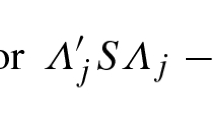Abstract
Aitken's generalized least squares (GLS) principle, with the inverse of the observed variance-covariance matrix as a weight matrix, is applied to estimate the factor analysis model in the exploratory (unrestricted) case. It is shown that the GLS estimates are seale free and asymptotically efficient. The estimates are computed by a rapidly converging Newton-Raphson procedure. A new technique is used to deal with Heywood cases effectively.
Similar content being viewed by others
References
Aitken, A. C. On least squares and the linear combination of observations.Proceedings of the Royal Society of Edinburgh, 1934–35,55, 42–48.
Anderson, T. W. Some scaling models and estimation procedures in the latent class model. In U. Grenander (Ed.),Probability and statistics: The Harald Cramér volume. New York: Wiley, 1959, Pp. 9–38.
Anderson, T. W. & Rubin, H. Statistical inference in factor analysis.Proceedings of the Third Berkeley Symposium on Mathematical Statistics and Probability. Berkeley: University of California Press, 1956. Pp. 111–149.
Browne, M. W. Analysis of covariance structures. Paper presented at the annual conference of the South African Statistical Association, October 1970.
Clarke, M. R. B. A rapidly convergent method for maximum-likelihood factor analysis.The British Journal of Mathematical and Statistical Psychology, 1970,23, 43–52.
Ferguson, T. S. A method of generating best asymptotically normal estimates with application to the estimation of bacterial densities.Annals of Mathematical Statistics, 1958,29, 1049–1062.
Harman, H. H.Modern factor analysis. (2nd ed.) Chicago: University of Chicago Press, 1967.
Jennrich, R. I. & Robinson, S. M. A Newton-Raphson algorithm for maximum likelihood factor analysis.Psychometrika, 1969,34, 111–123.
Jöreskog, K. G.Statistical estimation in factor analysis. Stockholm: Almqvist & Wiksell, 1963.
Jöreskog, K. G. Some contributions to maximum likelihood factor analysis.Psychometrika, 1967,32, 443–482.
Lawley, D. N. A modified method of estimation in factor analysis and some large sample results.Proceedings of the Uppsala Symposium on Psychological Factor Analysis, March 17–19, 1953. Nordisk Psykologi's Monograph Series No. 3. Stockholm: Almqvist & Wiksell, 1953. Pp. 35–42.
Lawley, D. N. Some new results in maximum likelihood factor analysis.Proceedings of the Royal Society of Edinburgh, Section A, 1967,67, 256–264.
Malinvaud, E.Statistical methods of econometrics. Chicago: Rand-McNally. 1966.
Neyman, J. Contribution to the theory of x2 test.Proceedings of the First Berkeley Symposium on Mathematical Statistics and Probability. Berkeley: University of California Press, 1949, Pp. 239–273.
Rothenberg, T. Structural restrictions and estimation efficiency in linear econometric models. Cowles Foundation Discussion Paper No. 213. New Haven, Conn.: Yale University, 1966.
Taylor, W. F. Distance functions and regular best asymptotically normal estimates.Annals of Mathematical Statistics, 1953,24, 85–92.
Wilkinson, J. H.The algebraic eigenvalue problem. Oxford: Oxford University Press, 1965.
Zellner, A. An efficient method of estimating seemingly unrelated regressions and tests for aggregation bias.Journal of the American Statistical Association, 1962,57, 348–368.
Author information
Authors and Affiliations
Additional information
The work on this project was done when the first author was Research Statistician at Educational Testing Service, Princeton, N. J. The second author was in part supported by a grant from the Research Committee of the University of Wisconsin Graduate School. The authors wish to thank Michael Browne for many helpful comments and Marielle van Thillo for valuable assistance in the numerical computations.
Rights and permissions
About this article
Cite this article
Jöreskog, K.G., Goldberger, A.S. Factor analysis by generalized least squares. Psychometrika 37, 243–260 (1972). https://doi.org/10.1007/BF02306782
Received:
Revised:
Issue Date:
DOI: https://doi.org/10.1007/BF02306782



